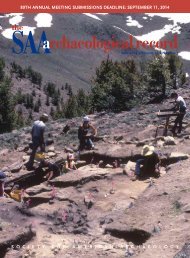SAA
Nov2016_web
Nov2016_web
You also want an ePaper? Increase the reach of your titles
YUMPU automatically turns print PDFs into web optimized ePapers that Google loves.
VIDEO GAMES AND ARCHAEOLOGY<br />
investigation of the genre of walking simulator video games<br />
as a digital flaneur, in which the digital material culture is<br />
more important than the gaming mechanics. González-<br />
Tennant speaks to the utility of the walking simulator video<br />
game in constructing places and archaeological narratives.<br />
Yet it should be noted that most gameplay does not respect<br />
the integrity of digital artifacts. The respondents to VALUE’s<br />
survey mentioned earlier felt that any archaeological or historic<br />
themes were overshadowed by what they see as “looting”<br />
behavior within video games, such as crushing old pots<br />
or destroying tombs for treasure. This is further expanded<br />
on by Dennis, who writes about the applicability of current<br />
archaeological ethics to video games and virtual material culture.<br />
She also expands on aspects of gamer culture that are<br />
potentially abusive to academics studying video games, a<br />
caution for those who wish to engage with this particular<br />
medium.<br />
Beyond the archaeological investigation of existing video<br />
game cultures and landscapes, archaeologists are increasingly<br />
modifying games or creating their own games. In my<br />
submission to this special section, I encourage an interventionist<br />
attitude toward popular games. After building Çatalhöyük<br />
in the open world of Second Life and Star Carr in<br />
Minecraft, I found myself surprised at the creativity and<br />
engagement that players had with the archaeological sites.<br />
Several archaeologists are using the Unity game engine as a<br />
platform to reconstruct archaeological sites and to make<br />
archaeology-themed games. As mentioned previously,<br />
González-Tennant explored the walking simulator by using<br />
Unity to reconstruct Rosewood, Florida, a community<br />
destroyed in 1923 in a week-long incident of race-based violence.<br />
As a testament to the flexibility of the platform, Hiriart<br />
used Unity to create an Anglo-Saxon landscape in England.<br />
Hiriart is not an archaeologist, but a game developer and lecturer<br />
interested in telling microhistories through games.<br />
Copplestone also used Unity for a very different game,<br />
Adventures in the Gutter, that does not reconstruct an archaeological<br />
landscape but invites the player to assume the role<br />
of an archaeologist making interpretive decisions, one from<br />
the British Museum and the other as a field archaeologist. In<br />
all of these instances, the authors note the utility of making<br />
the game in provoking new questions regarding archaeological<br />
practice.<br />
In this issue I have gathered voices from the #Archaeogaming<br />
community of archaeological explorers and makers that<br />
demonstrate the vibrant interdisciplinary research within the<br />
archaeology of video games. I encourage the readers of the<br />
<strong>SAA</strong> Archaeological Record to join the conversation and to<br />
come with us to explore new digital vistas. Note that not all<br />
publications mentioned in this introduction are included in<br />
this issue. Three articles by Colleen Morgan, Tara Copplestone,<br />
and Erik Champion will appear in a subsequent issue<br />
in 2017.<br />
References Cited<br />
Perry, Sara, and Colleen Morgan<br />
2015 Materializing Media Archaeologies: The MAD-P Hard<br />
Drive Excavation. Journal of Contemporary Archaeology 2(1):94–<br />
104.<br />
Watrall, Ethan<br />
2002 Interactive Entertainment as Public Archaeology. <strong>SAA</strong><br />
Archaeological Record. 2(2):37–39.<br />
10 The <strong>SAA</strong> Archaeological Record • November 2016




